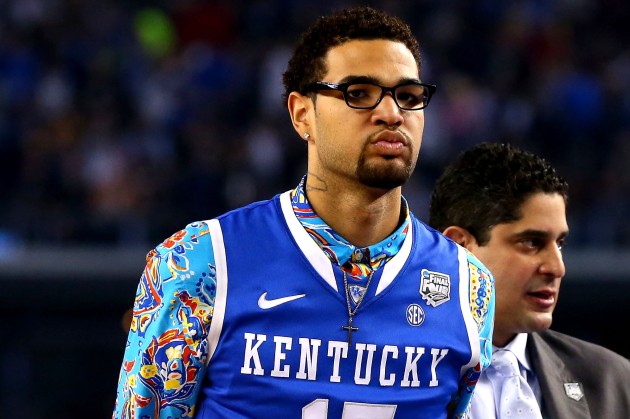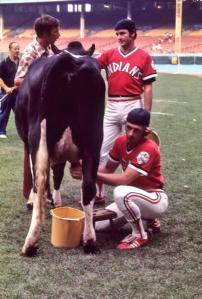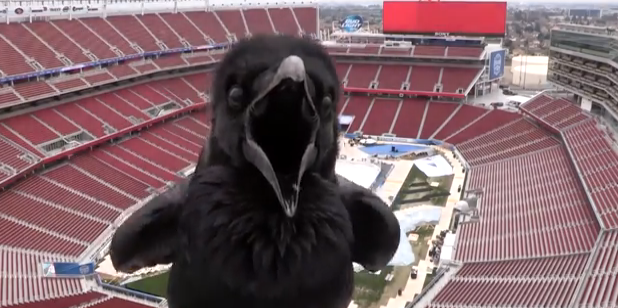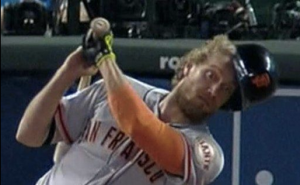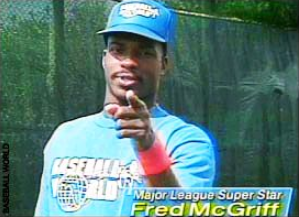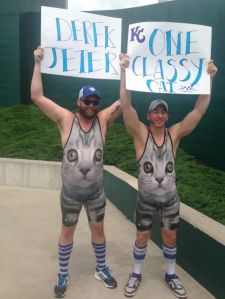Don’t Hate The Player – Hate The Game
As someone who doesn’t have a horse in the race, my rooting allegiance was available for the NCAA tournament. Kentucky is the odds-on favorite to win it all and has a chance to be the first team since the 1976 Indiana Hoosiers to go undefeated (note: the tournament included only 32 teams in 1976). This article goes beyond the reasons Kentucky will or will not win the title; rather, Sharp makes argument for why as the headline suggests, the team matters. For instance, Coach John Calipari might be hated for recruiting “1-and-done” players, but all the major programs have followed his lead to a lesser degree of success. Furthermore, attracting super recruits is one challenge; getting a group of them to understand that playing as a team ultimately better for the individual player’s future is quite another challenge. And ultimately, the product is more entertaining during a time when the college game has become slow, low-scoring, and devoid of upper-classmen with NBA talent. Taking all of this into consideration, go Wildcats. – PAL
Source: “Kentucky Is the Only Team That Matters”, Andrew Sharp, Grantland (3/19/15)
TOB: #theyjustjealous. Every other coach wishes he could recruit the kind of talent that Calipari does every year. This is a true story: Kentucky has a guy named Marcus Lee. Lee is a 6’9 PF from the Bay Area. He was ranked as high as #19 in the country out of high school. He picked Kentucky, with Cal as his #2. Lee and his family explained that while they knew he wouldn’t get much playing time at Kentucky, he had a better chance of making the NBA by playing against the one-and-dones at Kentucky in practice every day for four years, than he did as the best player at Cal. Now, I don’t know if I agree with this, but it’s not insane. As I was writing the preceding sentence, I heard Calipari say at halftime of their first round game against Hampton, “It was nice I could get Marcus Lee into the game because (Cauley-Stein) had foul trouble.” Lee, who probably could have helped transform Cal’s basketball program, is a garbage time afterthought at Kentucky (he averages 11 mins and 2.7 points per game). I can’t be mad at that, though. Kentucky is undefeated and outscoring opponents by twenty-one points per game. They beat tournament teams UNC and UCLA by 24 and 39. They beat Kansas (a #2 seed) by 32! They are fun to watch – I hope they meet Arizona in the Final Four (who I think is even more fun). It will be can’t miss television.
Who Am I? (What’s My Name)
Guillherme Fuck is a college basketball player in Canada. He’s from Brazil. His last name, as you can see, has made some…uncomfortable. But Fuck embraces his name and so should we. I hope he runs for office one day. -TOB
Source: “What’s in a Name? Fuck Proud of His”, Ryan McCracken, Medicine Hat News (03/19/2015)
Chalk One Up For The Geezers
With a kiss! Send it in, Jerome! Bill Raftery (73) has one of the most recognizable voices (and catch phrases) in college basketball, so it shocked me to discover he’s never called the Final Four on television until this year. He’s never complained or lobbied for the job, even when he’s been passed over for younger, and in some cases far less experienced candidates. He also represents a group of geezers that have no intention of retiring (I don’t believe the Jim Boeheim “retire in three years b.s. any more than you do). Legendary announcer Dick Vitale (76), SMU coach Larry Brown (74, and damn, did they get hosed in that game or what), and defiant Syracuse coach Boeheim (70) all keep chugging along. Unlike the others, who have reached the pinnacle of their respective professions – Brown is the only coach ever to win both an NCAA and NBA title, Boeheim got a title behind a teenaged Carmelo Anthony, Vitale as the pop culture icon – this is Raftery’s first time to the mountaintop. Good on you, Bill Raftery. You deserve it. -PAL
Source: “At 73, a First TV Job at the Final Four”, Richard Sandomir, The New York Times (3/16/15)
TOB: As if Billy Packer for decades wasn’t bad enough, whoever chose Clark Freakin Kellogg over Raftery for the Final Four should be tried for crimes against humanity. And then Greg Anthony after that!? The stated reason of not wanting to break up Verne Lundquist and Raftery is bull. I’m excited for Raftery – I just wish it had happened sooner. At 74, he’s not quiiiiiite the announcer he used to be. Nonetheless, I expect at least one, “ONIONS IN INDY!” at the Final Four. I can’t wait.
One Player’s Pre-emptive Strike Against CTE
As you’re probably aware, 49ers linebacker Chris Borland retired unexpectedly this week. Borland had a very promising rookie year. But he walked away, after just one season and less than one million dollars in career earnings, because he was afraid of what the game of football might do to his brain. The news was shocking, especially to 49ers fans, who have experienced an almost comically bad offseason. As you can imagine, a lot of words were written about Borland’s decision. These were two of my favorites. -TOB
Source: “Everyone Wants Chris Borland to Mean Something”, Barry Petchesky, Deadspin (03/17/2015); “The Definition of Tough: How Chris Borland Walked Away From His Dream Job”, Bill Barnwell, Grantland (03/17/2015)
PAL: “At this point, it’s about the fact that football destroys some or many of the people who play it, and the consequences of that knowledge.” That’s the best description of where the NFL (and the country) is at with the CTE situation. Now that we have the knowledge, what do individuals do with it? Some players will say, “screw it,” and play anyway, and some won’t. More important to the long-term future of football: what decision will parents make on behalf of their kids? What’s most shocking to me is when I hear retired players who are seemingly healthy and got out unscathed (Herm Edwards is one example) say they would go back and do it again while knowing the risks. Really? You were lucky enough to have made it through the gauntlet once, while other players have suffered horribly, and you’d risk it again? That’s arrogance. Above all, I think Borland displays humility and confidence by walking away now. He’s not foolish enough to think it (CTE) won’t happen to him, and he has the confidence to not define himself by football.
Crawford’s Web
Giants shortstop Brandon Crawford makes some incredible defensive plays. This article was a great idea by Giants beat writer Alex Pavlovic, who sat down with Crawford to break down five of his best. Crawford explains what went through his head, how he made the play, and how he feels watching them now. I enjoyed it thoroughly. -TOB
Source: “Giants’ SS Crawford Breaks Down Top 2014 Defensive Gems”, Alex Pavlovic, CSN Bay Area (03/18/2015)
PAL: Beer on me for whomever posts a picture or short video of the following (someone take me up on this already, dammit!). Go to your local field (regulations size, folks), stand where the infield dirt meets the outfield grass 20 feet from the third base line, and throw a ball to first base. You’ll find it’s a hell of a long throw. Imagine diving for a ground ball, getting up, and making a throw to first base in time to beat a professional athlete to the bag. Someone please do this. Pat O’Brien, Al Pflepsen, and Ryan Nett, Ryan Rowe – I’m looking at you. In fact, Tommy and I might be cooking up a video series idea to try to recreate the best plays of each month from this upcoming season. You can already file it under comedy. Crawford is a maestro.
The Manhattan Project of College Sports
This week, Notre Dame Athletic Director Jack Swarbrick, the most influential AD in the NCAA, just pulled a Harry Truman, announcing the college sports atomic bomb. This has been brewing for years, but to hear the Notre Dame AD come out and present it as a viable plan is more than a little shocking. Swarbrick addresses the movement toward paying college players, and how some schools just will not go there (e.g. Notre Dame and Stanford). He proposes a move to two associations. Teams like Alabama and Oregon, who are committed to winning football at all costs, would go in one association. In the other association would be teams like Notre Dame and Stanford, following more of an Ivy League model. He believes that Notre Dame will still command a major TV contract even if they are not playing the other elite teams. I’m not so sure, and this seems like a major gamble for him. Will ND’s nationwide fans continue to follow the team if they move to what will be viewed as a lower division? I also found the placement of my alma mater, Cal, in the same division as Notre Dame as interesting. No doubt, the administration would want to join that league. But Cal just renovated their stadium a few years ago and need to pay off around $300 million over the next 40 years. Can they afford the move to the lower division? I am skeptical. -TOB
Source: “Notre Dame AD Has a Vision of Two Collegiate Athletic Associations”, Dennis Dodd, CBS Sports (03/18/2015)
PAL: Let’s say this happened tomorrow. Notre Dame Football would be (more) irrelevant within 3 years, if not sooner. The coach would bolt, and boosters would have Swarbrick canned long before that. Perhaps one example of collateral damage in the eventual payment of college athletes is Notre Dame becoming a note in a sports almanac. Also, you are delusional if you don’t think Notre Dame athletes are receiving “benefits” right now. My advice: Lean into it, Mr. Swarbrick.
TOB: With the rare counterargument: From what I have read, Swarbrick is extremely intelligent and good at his job. It would shock me if, before he went public with this, his message was not run by (1) ND Administration and (2) NBC Sports Execs. I find it hard to believe that this mandate is not coming from his school’s higher ups – ND fancies itself in the rarefied air just below the Ivies, and they truly may not want to go to a pay-for-play model. But, I find it hard to believe they’d also forego the TV money they get from NBC. Perhaps they convinced NBC that they’d still draw ratings (though I think, as Phil said, it would not take long for viewers to tune out).
Video of the Week
This week’s video is another edition of MLB Statcast, where they use science to break down amazing plays. This play is the near-double play the Giants pulled on the Cardinals after the deflection off of He Who Shall Not Be Named’s glove in Game 5 of the NLCS. Click the image to load the video.

Like what you’ve read? Let us know by following this blog (on the right side, up near the top), or:
Email: 123sportslist@gmail.com
“What kind of person could ever cheer for that Duke team over the Fab Five? Is that someone you would ever want to be friends with?”
-Chris Ryan, Grantland

